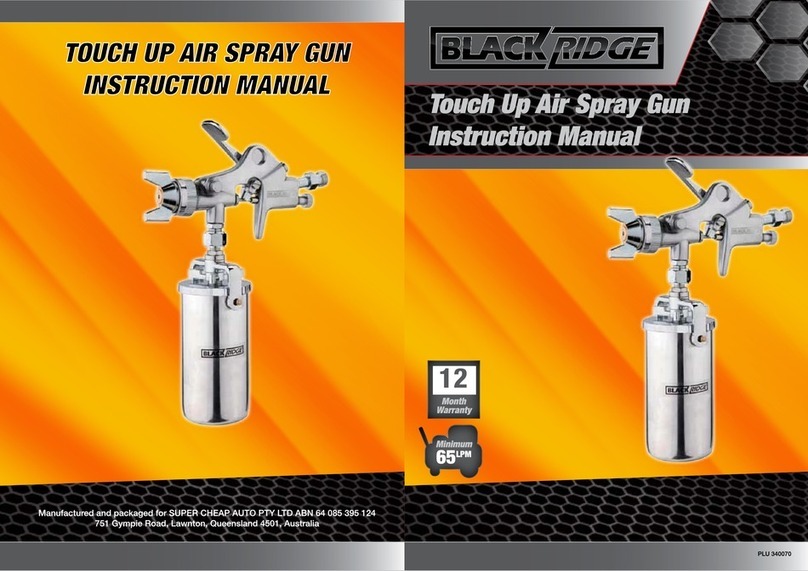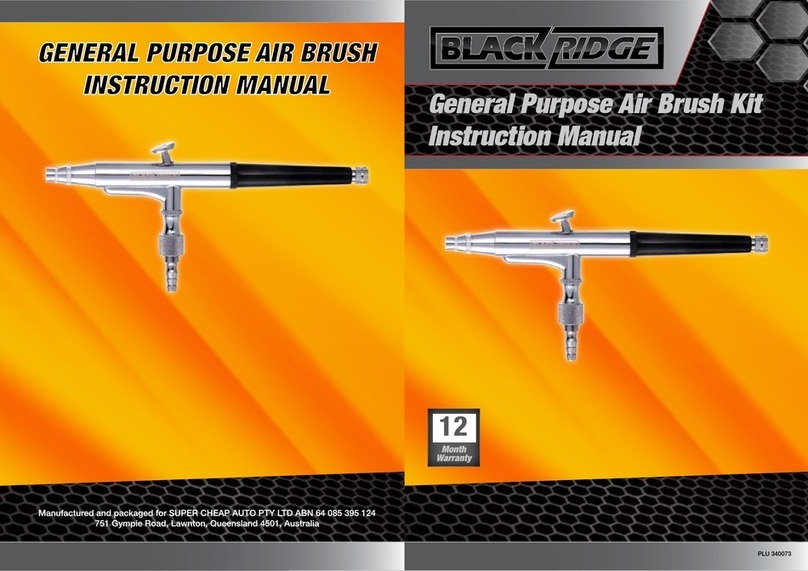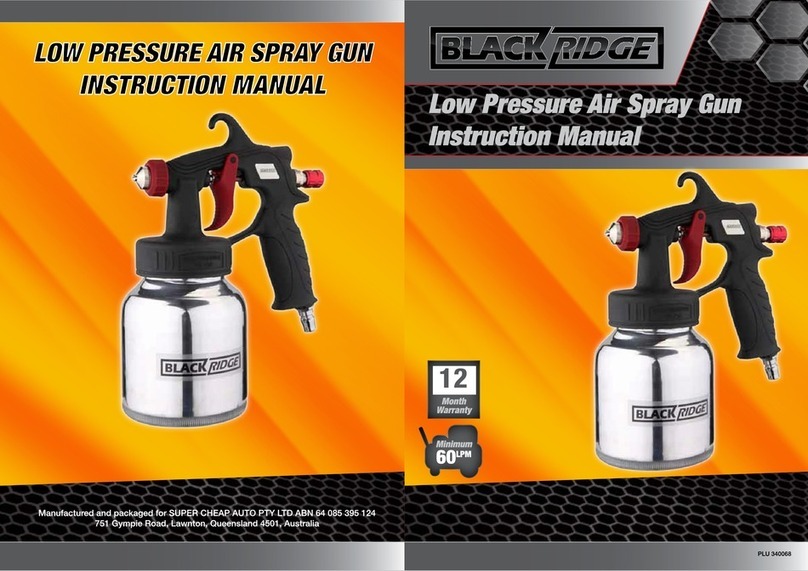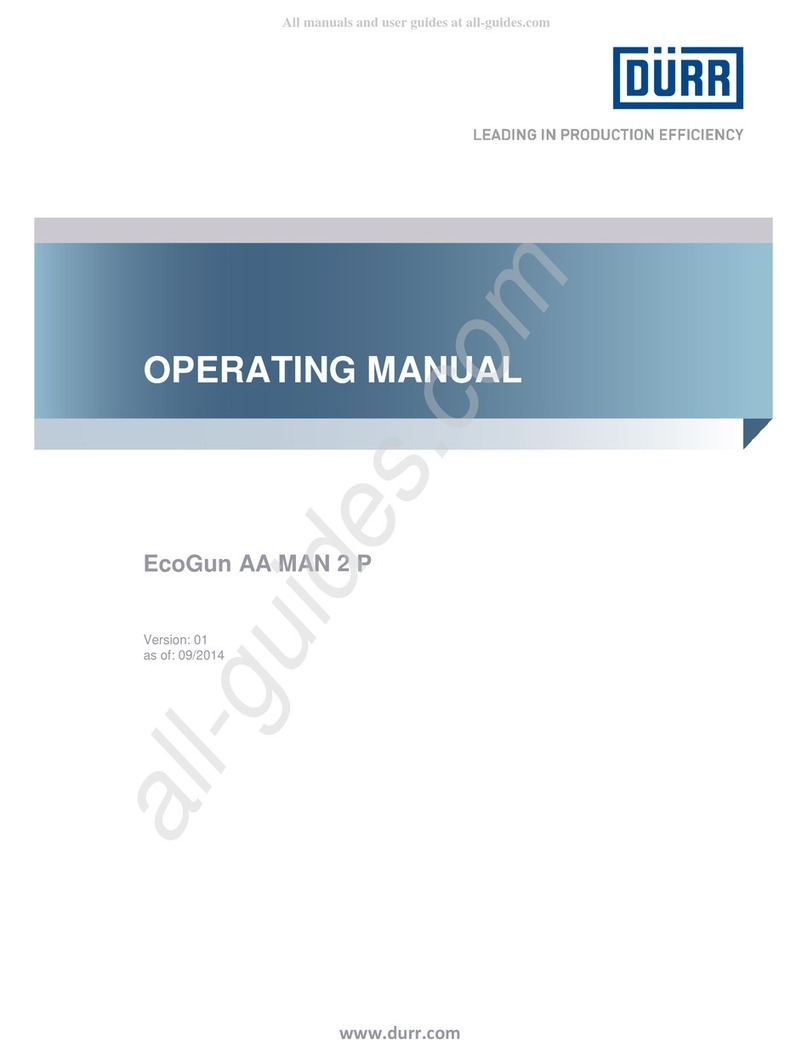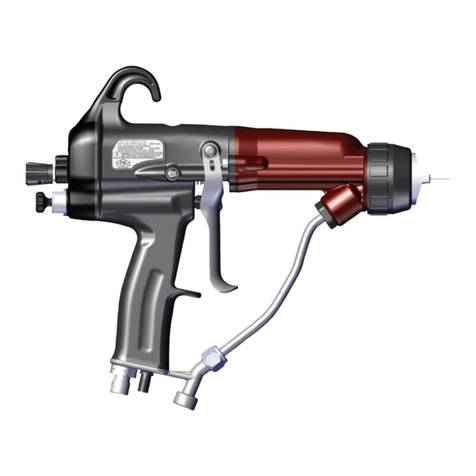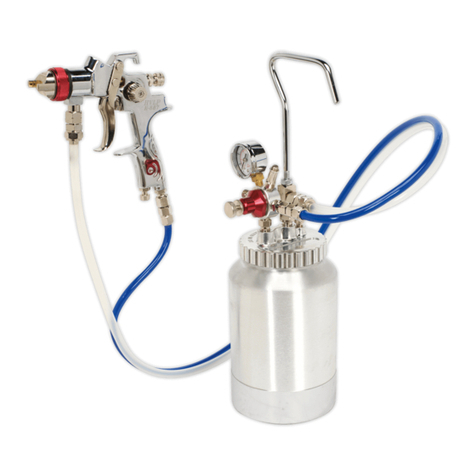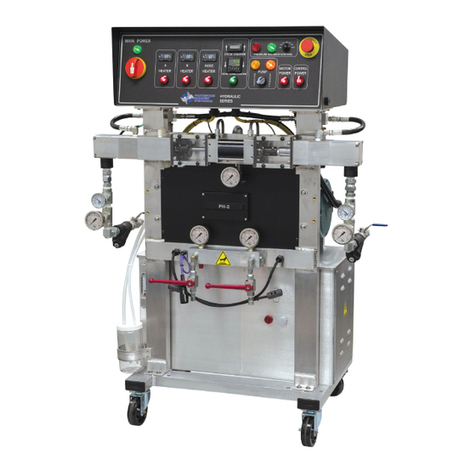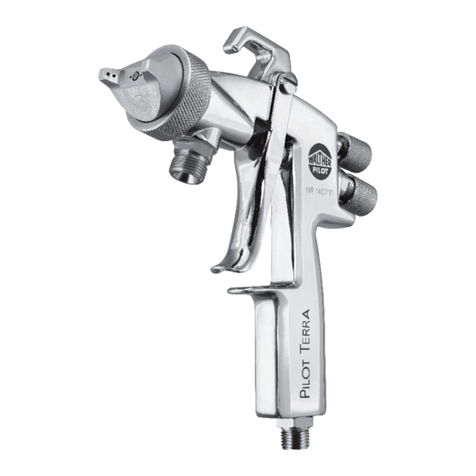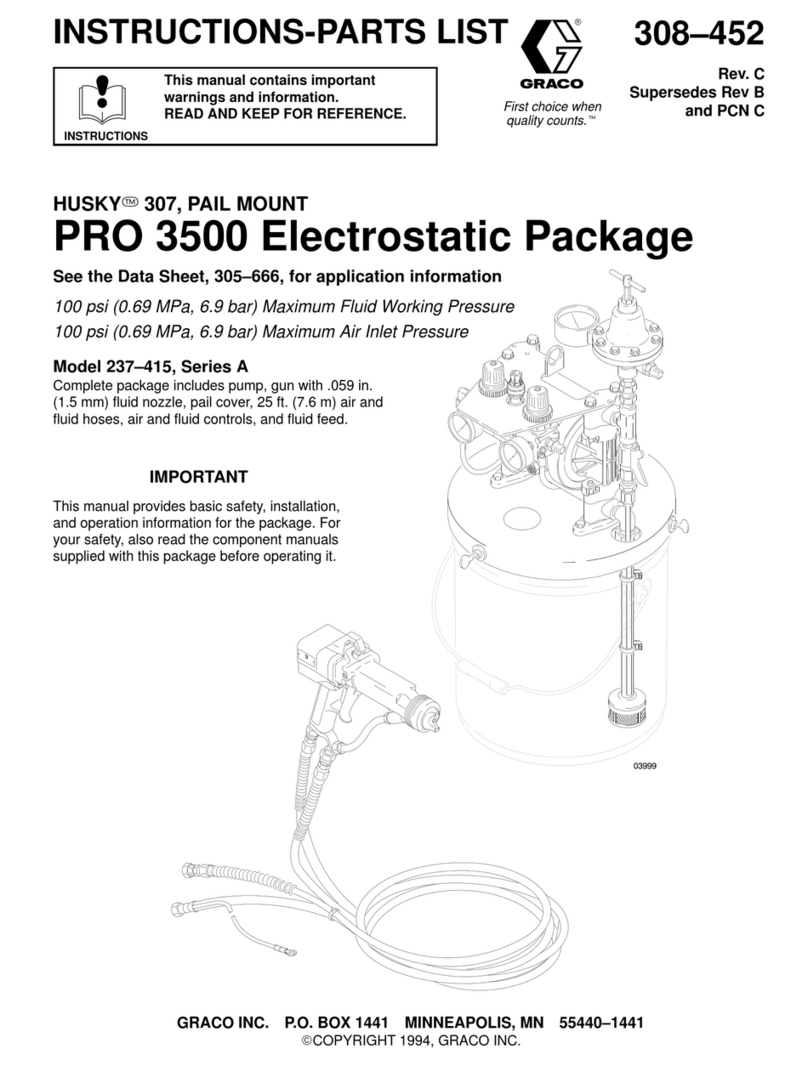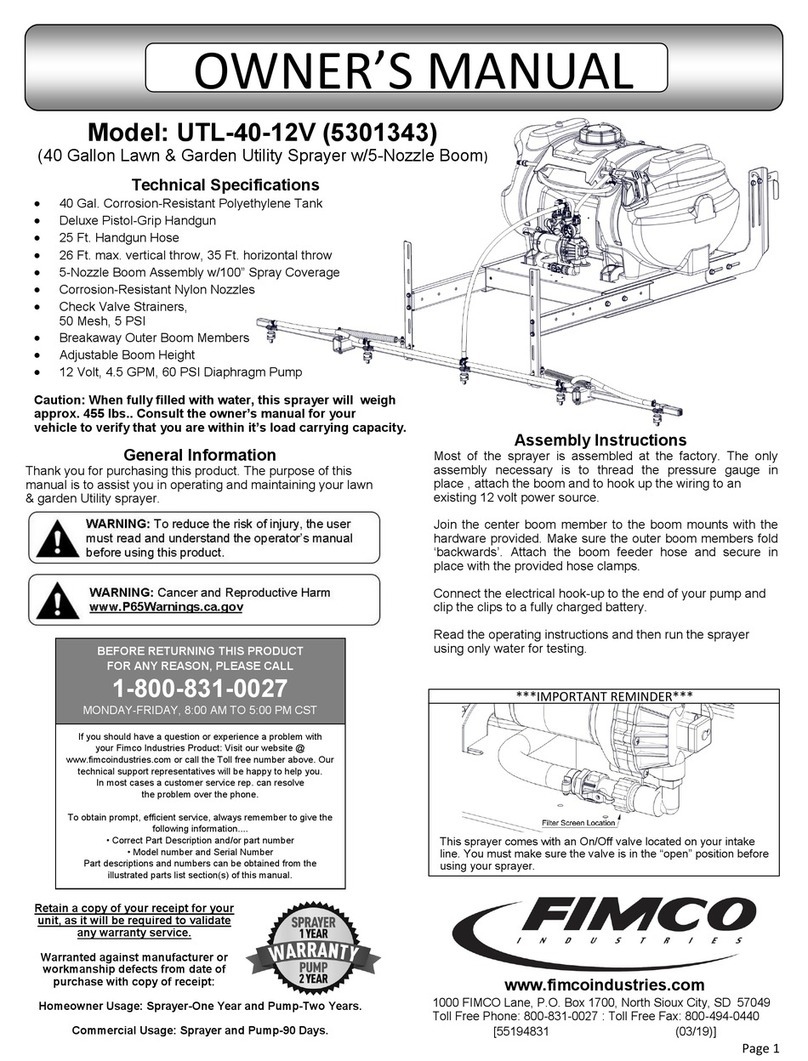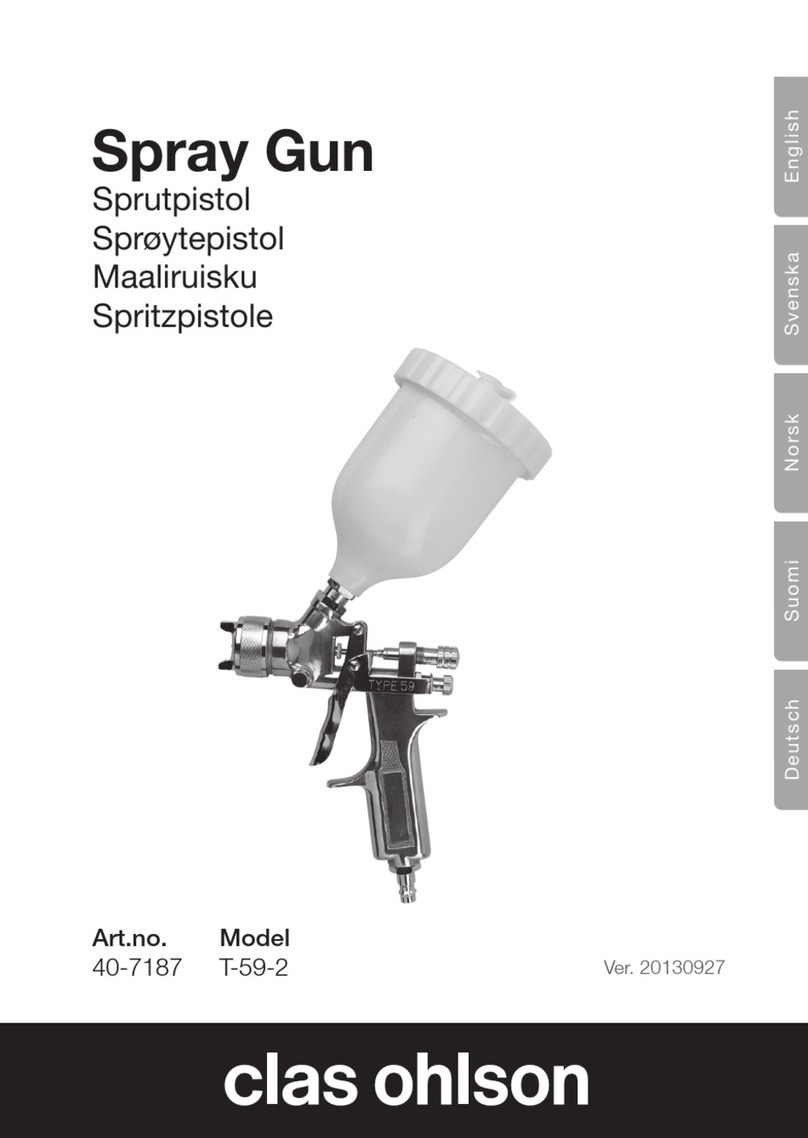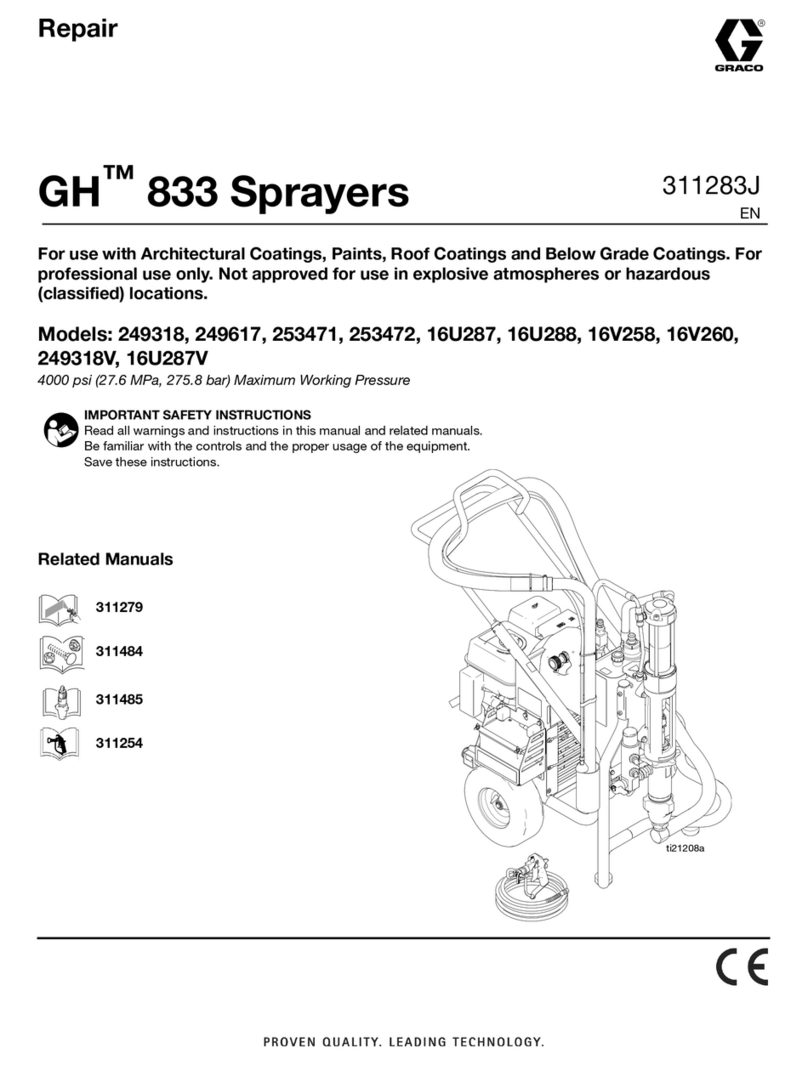Black Ridge S-770S User manual


1 2
Model: S-770S
Standard Nozzle: 2.0mm (nozzle size range: 1.5-2.0mm)
Max Operating Pressure: 50 PSI (3.45 BAR)
Minimum Air Consumption: 110 LPM
Fluid Delivery: 0.24-0.30 LPM
Painting Fan: 180-220mm (at distance of 10”)
Cup Size: 1000ml
Air Inlet: 1/4”
Cluttered areas invite injuries. Avoid any ignition
sources, such as smoking, open flames and similar hazards.
Do not use machines or power
tools in damp or wet locations. Do not expose to rain. Keep work area illuminated.
Children should not be allowed in the work area. Do
not let them handle machines, tools or extension cords.
When not in use, tools must be stored in a dry
location to inhibit rust or corrosion. Always lock up tools and keep out of reach
of children.
Always use the tool for the specific
purpose it was intended.
Always wear the appropriate clothing suited to the
painting application.
WARRANTY
This product is guaranteed against defects for a period of 12 months from date of
purchase. This warranty is provided by Super Cheap Auto Pty Ltd ACN 085 395
124 (Supercheap Auto) of 751 Gympie Rd Lawnton QLD 4501 Ph (07) 3482 7500.
Supercheap Auto will offer a repair, replacement product or store credit if the product
is assessed as being defective during the warranty period.
To claim under this warranty, take this product to the Front Service Desk of your nearest
Supercheap Auto store. For store locations, visit www.supercheapauto.com.au (AUS)
or www.supercheapauto.co.nz (NZ). You will need your receipt or proof of purchase.
Additional information may be requested of you to process your claim. Should you not
be able to provide proof of purchase with a receipt or a bank statement, identification
showing your name, address and signature may be required to process your claim.
This product may need to be sent to the manufacturer to assess the defect before
determining any claim. Faults or defects caused by product modification, misuse and
abuse, normal wear and tear or failure to follow user instructions are not covered under
this warranty.
Our goods come with guarantees that cannot be excluded under the Australian
Consumer Law. You are entitled to a replacement or refund for a major failure and
for compensation for any other reasonably foreseeable loss or damage. You are also
entitled to have the goods repaired or replaced if the goods fail to be of acceptable
quality and the failure does not amount to a major failure.
Any expenses incurred relating to the return of this product to store will normally have
to be paid by you. For more information contact your nearest Supercheap Auto store.
The benefits to the consumer given by this warranty are in addition to other rights and
remedies of the Australian Consumer Law in relation to the goods and services to
which this warranty relates.

3 43 4
• Connect the air source hose to the gun. Make sure the air pressure does not
exceed 50 PSI (3.45 BAR).
• Hold the gun perpendicular to the spraying area and then move it parallel several
times.
• The stroke should be started before the trigger is pulled and the trigger should
be released before the stroke is ended. This can control the gun and material.
• Keep the appropriate distance of 6” to 12” between the gun and spraying area,
according to the atomisation pressure and work demand.
To reduce overspray and obtain maximum efficiency, always spray with the
lowest possible atomisation fluid pressure.
The desired pattern, volume of fluid output and fine atomisation can easily be
obtained by tuning the fan adjusting knob, fluid adjusting knob and air adjusting
knob.
Fan adjusting knob Turn right. Pattern is round.
Turn left. Pattern is fan.
Fluid adjusting knob Turn right. Decrease fluid output.
Turn left. Increase fluid output.
Air adjusting knob Turn right. Decrease air volume.
Turn left. Increase air volume.
Fan adjusting knob
Fluid adjusting knob
Air adjusting knob
Always wear appropriate eye protection when
operating a spray gun.
Keep proper footing and balance at all times. Do not
reach over or across running machines.
Watch what you are doing and use common sense. Do not
operate any tools when you are tired.
Before using any tool, any part that appears
damaged should be carefully checked to determine if it will operate properly
and perform its intended function. Any part that cannot fulfill it’s intended
purpose should be replaced.
When servicing, use only
identical replacement parts.
Read warning labels on prescriptions to determine if your judgement
or reflexes will be impaired while taking drugs. If there is any doubt, do not
operate the tool.
• Check and replace any damaged or worn parts.
• Make sure the nozzle and air trigger are free to operate correctly.
• Pour paint into the paint cup.
• Attach the cup to the spray gun. Make sure the lid is securely tightened and the
vent tube is secured.
When filling or refilling the material, disconnect your gun from the air
supply to avoid accidental spillage or spraying.
(for best results you should incorporate an
air regulator with filter).

3 45 6
• Pour remaining paint into another container and then clean paint cup and air
nozzle. Spray a small amount of thinner to clean the passage. Incomplete
cleaning will cause an adverse pattern shape. Clean thoroughly, immediately
after use.
• Clean other sections with a cloth soaked with thinner.
• Ensure paint passages have been completely cleaned before disassembly.
• Remove fluid nozzle after removing fluid needle set or while keeping fluid
needle pulled, in order to protect seat section.
Never use wire or other hard objects to clear the nozzle or clean the
fluid needle. This will cause damage to the components. Never immerse the whole
gun into solvent such as thinner as it will damage the air nozzle, fluid nozzle and
needle.
Spray gun spits. Loose fluid nozzle. Tighten securely.
Needle adjustment knob
loose. Tighten.
Loose cup lid. Tighten.
Spray gun fails to spray.
Vent hole on cover or
fluid connecting nut
clogged.
Dismantle and clean,
thin paint as required.
Thick paint. Dilute or use bigger
capacity fluid nozzle.
Nozzle clogged. Disassemble and clean.
Escape of air when the
trigger is released.
Air needle not sliding. Oil slightly.
Air valve sealing seat too
tight. Loosen.

1 Sealing Screw 1 18 O Ring 6x2.0 1
2 Sealing Gasket 3 19 Needle Socket 1
3 Air Valve Spring 1 20 Needle Seat 1
4 Air Valve Stem 1 21 Needle Adj. Spring 1
5 O Ring 7.5x1.8 2 22 Needle Adj. Knob 1
6 Air Valve Body 1 23 Pattern Adj. Stem 1
7 O Ring 2.5x1.8 3 24 Pattern Adj. Spring 1
8 Sealing Gasket 1 25 Material Passage
Connector
1
9 Air Valve Seat 1 26 Bolt M9x1 (B) 1
10 Airflow Adj. Stem 1 27 Hexagon Coupling
Nut
1
11 Gasket 3 4 28 Hexagon Nut 1
12 Airflow Adj. Spring 1 29 Material Tube 1
13 Airflow Adj. Seat 2 30 Air Screw 2
14 Airflow Adj. Knob 2 31 Air Tube 1
15 Opening Stopper
4.0
1 32 Hexagon Locking
Nut
1
16 Trigger 1 33 Sealing Gasket 1
17 Trigger Pin 1 34 Rivet 2
35 Rivet 2
3 47 8
NOTE:
When spray painting consider the size of the job and the size of your air
compressor being used. When spray painting large jobs like a fence or car, a Belt
Drive Air compressor is recommended. Always refer to the duty cycle of your air
compressor before spray painting.
Table of contents
Other Black Ridge Paint Sprayer manuals

